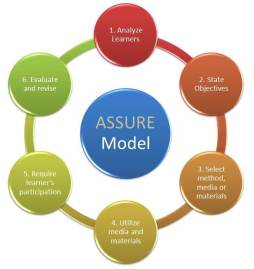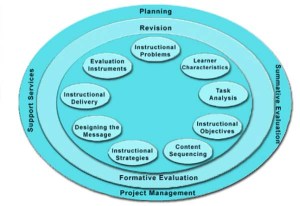Over the last few months I’ve conducted extensive research into instructional design models used in the process of course design. I’ve researched the history of instructional design [also known as ‘instructional systems design’] and its applications from the 1930’s to present. I’m writing, or least attempting to write, a book for educators that describes how to develop effective, relevant courses in our digital age using a dynamic instructional design model. The first chapter covers the history of instructional design with a focus on education learning environments as opposed to business or military settings. And though I’ve found considerable literature about design principles, methods and models applicable to higher education, there is dearth of published writings on instructional design models specific to K-12.
K-12 Educators Need Instructional Design Skills
Even in current literature there appears to be few resources for K-12 educators that provide instructional design models with accompanying principles to guide the development or re-design of courses for K-12 learning environments – whether it be for blended, face-to-face or online courses. However, the gap is justified by the fact that teachers for the most part, have access to already developed curriculum materials either via textbooks for specific subjects created by the publisher, materials created by instructional designers within a school district, or lesson plans/curriculum available via various platforms, i.e. Open Education Resources, Open Connexions, Discovery Education, museums for education, etc. However, I suggest that there is a need for K-12 educators to be equipped with skills in instructional design. Teachers need this skill set to adapt curriculum in order to provide relevant learning experiences for their students. Furthermore, with the proliferation of technology tools and applications that teachers have access to and are even encouraged to use, i.e. the flipped classroom method, or iPads, suggests that teachers need to know how to use these tools effectively—to be able to assess if, and how a given education tool supports the desired learning objectives. And if it does, how to incorporate the tool using a sound pedagogical strategy. I’ve encountered several examples of instructional design advice for K-12 teachers that are well-meaning, but fall short on pedagogy and instructive guidelines for implementation.
The lack of a current instructional design model for K-12 and higher education is partly what has motivated me to create one – however the purpose of this post is to review existing models specific to K-12 and examine the principles of each to identify what may be useful in today’s learning contexts. I also encourage readers to share any design experience or advice that might be helpful to other readers.
Instructional Design Models Defined
Before reviewing details of the models, I’ll share a definition – what a course design model is, and why a design model is even worth considering.
“Models, like myths and metaphors, help us to make sense of our world. Whether derived from whim or from serious research, a model offers its user a means of comprehending an otherwise incomprehensible problem. An instructional design model gives structure and meaning to an I.D. [instructional design] problem, enabling the would-be designer to negotiate her design task with a semblance of conscious understanding. Models help us to visualize the problem, to break it down into discrete, manageable units.” – Martin Ryder, University of Colorado Denver, School of Education
Design Models Frequently Referenced for K-12 Learning
Though the definition and application of course design models vary widely, some educators have classified models into different types as the following article, Comparison of Alternative Instructional Design Models does:
“Instructional Design models are classified into three types, classroom, product and system (Gustafson & Branch, 2002). Classroom models are of interest to, and are usually designed for, professional teachers from K-12, community colleges, vocational schools, and other related areas. These models take into consideration the environment of teachers… The output of these models is small, a unit or module of instruction used within the school year.” – Marlene Fauser, Kirk Henry, and David Kent Norman
In principle I disagree with this classification and description. Instructional design models should be flexible enough to be applied to all learning environments – K-12, face-to-face, blended environments, higher education, etc. However, there is value in analyzing the models, and identifying previous and current applications in various settings—in this instance K-12.
Gerlach/Ely Model
In 1971 Vernom S. Gerlach and Donald P. Ely developed the Gerlach & Ely instructional model; a prescriptive model that is most suitable to instructional planning/designing when the learning objectives and instructional content are predetermined. Its key feature is that the steps of content selection and specification of objectives are completed synchronously (diagram below), making it applicable to a K-12 environment.
ASSURE
The ASSURE model developed by Heinich, Molenda, Russell & Smaldino uses an acronym to describe its fundamental principles: Analyze Learners, State Objectives, Select media and materials, Utilize media and materials, Require learner participation, and Evaluate and revise. Sharon Smaldino’s following statement [teacher and one of the model’s creators] describes the philosophy of the model, “To ASSURE good learning, I believe it is not one single thing that a teacher or designer should consider, but I do believe that there are areas of emphasis“. instructional Design.org
Morrison, Ross and Kemp Model
This model is the most flexible. The circular nature suggests that design is fluid, with no specific beginning point, which the authors describe as adaptable. There are nine core elements that make up the model, and the diagram indicates that each element is mutually supporting. The textbook, Designing Effective Instruction written by the developers of the model (Morrison, Ross & Kemp) indicates that the focus of the model is for classroom instruction. The most recent edition of the book [now in its sixth], discusses the role of technology in the classroom and describes how to incorporate technological tools in instructional planning.
One of the benefits touted for this model is its flexibility due to the circular nature and lack of starting point, though I view this as a significant flaw in the design as it ignores key principles of creating effective instruction which does require at least a logical sequence based on how people learn.
Closing
I realize that I have only included a few of the many models, however the ones I’ve mentioned appear to be referred to, and implemented widely. Stay tuned for more posts about instructional design as I work through the research and writing of my book.
References:
- Comparing Instructional Design Models, Slideshare by Michael Grant
- Instructional Design Models, Martin Ryder, University of Colorado at Denver School of Education, http://carbon.ucdenver.edu/~mryder/itc/idmodels.html
- About the Kemp Model, PB Works
- Teachers can’t do instructional design, [blog post by a k-12 teacher] http://llcurious.wordpress.com/2010/12/14/teachers-cant-do-instructional-design/
- Comparison of Instructional Design Models, https://deekayen.net/comparison-alternative-instructional-design-models




This has been a very useful post, and I really appreciate the resources you directed us to. However, I do want to point out an area of disagreement related to the Morrison, Ross, and Kemp model. You stated that “one of the benefits touted for this model is its flexibility due to the circular nature and lack of starting point, though I view this as a significant flaw in the design as it ignores key principles of creating effective instruction which does require at least a logical sequence based on how people learn.” Based on my understanding of the model, the flexibility is afforded to the instructional designer or instructor who uses the model when designing instruction. It does not seem that poorly sequenced instruction would be a natural consequence of this approach. In fact, if the model is effectively implemented, the instruction should take into account how the audience leaners during the analysis of learner characteristics. Further it should sequence the tasks for maximum impact, because the designer would be take this into account during the task analysis step.
Regarding your statement that “Instructional design models should be flexible enough to be applied to all learning environments – K-12, face-to-face, blended environments, higher education, etc.”, I wanted to posit the view that there is a fundamental tension between flexibility and precision. What one gains through flexibility they may lose in detail and fidelity and vice versa.
LikeLiked by 1 person
You bring up several valid points. I also agree that there is tension between between flexibility and precision when it comes to instructional design, which is why I consider instructional design an art as much as it is an exercise in detail that follows a prescribed model. Thanks for your comments and for adding to a thoughtful discussion.
LikeLike
Smith and Ragan model is better suited to designing learning programs in schools.
LikeLike
We, at Classteacher ( classteacher.com ) have a very comprehensive library across pre-primary to Secondary school of 3D stero content. There are some startling case studies on how it has managed to engage all categories of learners. We welcome feedback from educators who have used 3D to share feedback with us in http://www.world.classteacher.com
LikeLike
GOOD COMPARISON… 😉 it really help in my study… 😉
LikeLike
Reblogged this on Caroline+Kühn and commented:
Excellent put together!
LikeLike
Thanks Caroline for the mention and for reblogging!
Debbie
LikeLike
You are very thoughtful in your posts. I follow your line of thoughts and have similar interest. Your blog has been very useful in my research. Thank you for sharing!
LikeLike
Thank you so much, this is very useful. Do you have one preferred model over the others, specifically at the K-12 level?
LikeLike
Glad you found this useful! The model that I prefer isn’t shown here — I prefer the Dick, Carey and Carey model. I prefer this model because of its comprehensiveness, as well as its consideration of the learner. In the process, the model encourages consideration of the learning context, and the learner context, two different but necessary aspects of developing a course that will be successful. I’ve seen courses that don’t factor in these two dimensions, and the result is a good course in format, but because critical factors are ignored about the learner, the course fails. 😦
Thanks for taking the time to engage in discussion.
Debbie
LikeLike
That’s hilarious, I’m currently reading “The Systematic Design of Instruction” (Dick/Carey/Carey) for one of my classes. I agree that it is an excellent model.The majority of the course has been the focus on analyzing and truly understanding their model, but I feel like it will pay off for the future.
Do you recommend any other books for further understanding of the design process?
LikeLike
What a coincidence! There is an excellent website that is packed full of excellent content… http://nwlink.com/~donclark/ and though it’s got some advertising, it’s overall an excellent site. A book that is not related exactly to course design, but I still found interesting is Innovation X — I believe the details of the book can be found on my Goodreads page, https://www.goodreads.com/review/list/12989284?shelf=current-non_fiction
Thanks again for interest and discussion.
Debbie
LikeLike
Thanks so much for the website recommendation. I’ve stumbled across that specific site several times, and now I’ll make sure to go back and read it. The book looks really interesting also, thanks, I’ll make sure to add it to my reading list 🙂
LikeLike